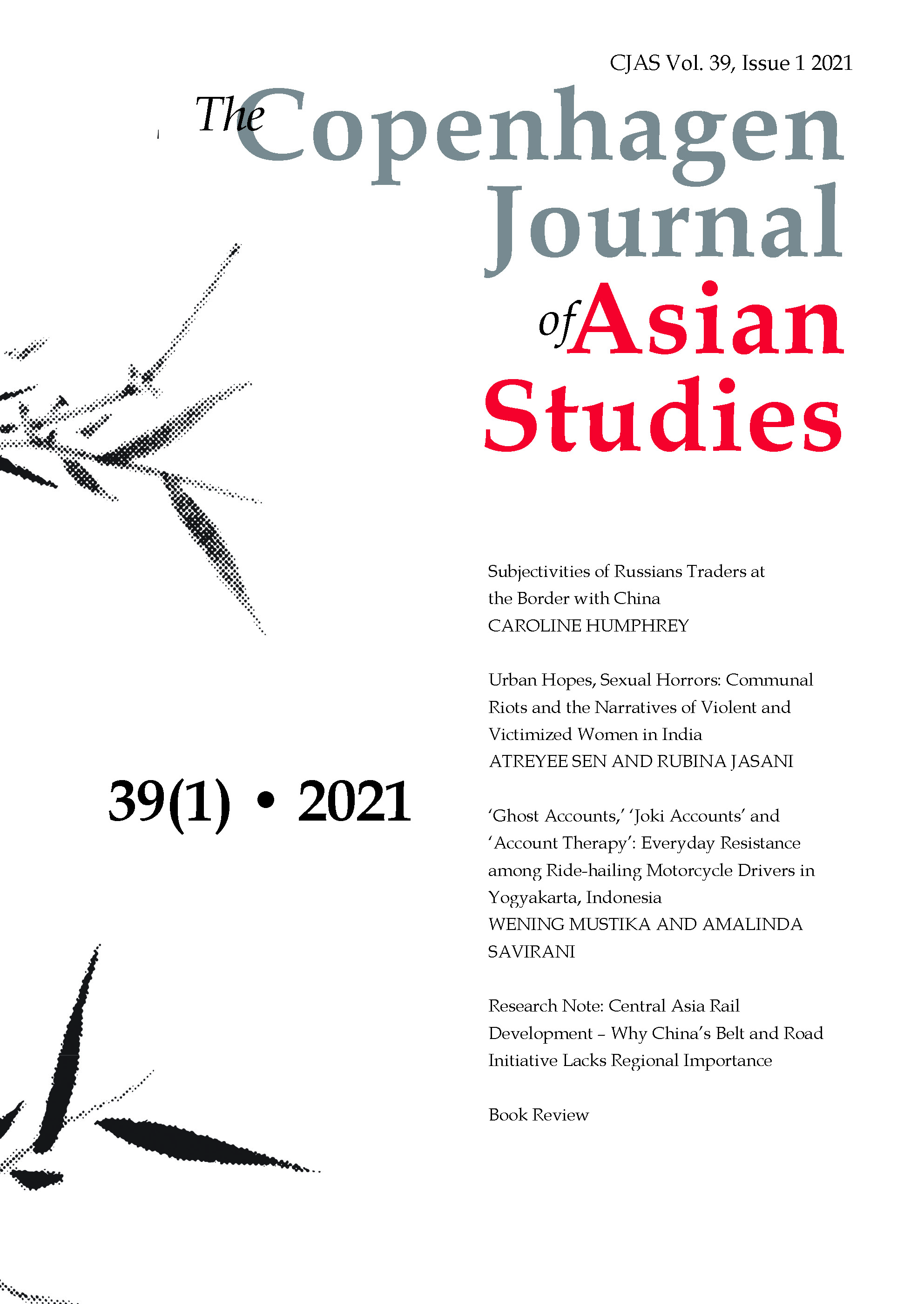Urban Hopes, Sexual Horrors
Communal Riots and the Narratives of Violent and Victimized Women in India
DOI:
https://doi.org/10.22439/cjas.v39i1.6176Keywords:
urban riots, gender, survival, narratives, sectarian violenceAbstract
Academic discussions of women and the eruption of urban riots in India focus on a range of women’s testimonies. From this perspective, Hindu women who belong to prominent and powerful right-wing organisations demonstrate religious and physical prowess, while minority and unprotected Muslim women are victims during outbreaks of communal violence. This article aims, if not to undermine, but to unsettle these gendered binaries in women’s experiences as victims or perpetrators of urban violence. We suggest that poor women on both sides of exclusionary propaganda and nationalistic discourses experience the actual violent eruption of hostilities as personal suffering and collective loss. Our analysis highlights how these experiences are intimately related to women’s domestic and family relations, bereavement, mobility, their peripheral socio-economic position, anxieties about the integrity of female bodies, etc., over and above women’s disillusionment with the state, secular and faith-based organisations.
References
Banerjee, Sikata 2005. Make Me a Man! Masculinity, Hinduism and Nationalism in India. Albany: State University of New York Press. https://doi.org/10.1017/s0021911807001726.
Banerjee, Sikata 2006. ‘Armed Masculinity, Hindu Nationalism and Female Political Participation in India’. International Feminist Journal of Politics 8 (1): 62-83. https://doi.org/10.1080/14616740500415482.
Bedi, Tarini 2007. ‘The Dashing Ladies of the Shiv Sena’. Economic and Political Weekly 42 (17): 1534-1541.
Chatterji, Roma and Deepak Mehta 2007. Living with Violence: An Anthropology of Events and Everyday Life. New Delhi: Routlege.
Connolly-Shaffer, Patricia 2012. Staging Cross Border (Reading) Alliances: Feminist Polyvocal Testimonies at Work. Ph.D. dissertation, University of Minnesota.
Das, Veena 2004. ‘The Signature of the State: The Paradox of Illegibility’. In Veena Das and Deborah Poole (eds.) Anthropology in the Margins of the State. New Delhi: Oxford University Press, pp. 225-52.
Farmer, Paul 1996. ‘On Suffering and Structural Violence: A View from Below’. Daedalus 125 (1): 261-283.
Fujii, Lee Ann 2010. ‘Shades of Truth and Lies: Interpreting Testimonies of War and Violence’. Journal of Peace Research 47 (2): 231-241. https://doi.org/10.1177/0022343309353097.
Ghassem-Fachandi, Parvis 2012. Pogrom in Gujarat: Hindu Nationalism and Anti-Muslim Violence in India. Princeton, NJ: Princeton University Press. https://doi.org/10.1515/9781400842599.
Gupta, Charu 2001. ‘The Icon of Mother in Late Colonial North India: “Bharat Mata”, “Matri Bhasha” and “Gau Mata”’. Economic and Political Weekly 36 (45): 4291-4299. https://doi.org/10.1057/9780230108196_5.
Gupta, Dipankar 2011. Justice before Reconciliation: Negotiating a 'New Normal' in Post-riot Mumbai and Ahmedabad. New Delhi: Routledge India. https://doi.org/10.4324/9780203085257.
Hansen, Thomas Blom 2001. Wages of Violence: Naming and Identity in Postcolonial Bombay. Princeton, NJ: Princeton University Press, https://doi.org/10.4000/lhomme.14202.
Jaffrelot, Christophe 2007. ‘The 2002 Progrom in Gujarat: the Post 9/11 Face of Hindu Nationalist Anti-Muslim Violence’. In John R. Hinnells and Richard King (eds.) Religion in South Asia: Theory and Practice. New York: Routledge, pp. 173–192. https://doi.org/10.4324/9780203088692-15.
Jasani, Rubina 2010. ‘A Potted History of Neighbours and Neighbourliness in Urban Ahmedabad’. In Edward Simpson and Aparna Kapadia (eds.) The Idea of Gujarat: History, Ethnography and Text. New Delhi: Orient Blackswan Private Limited, pp. 152-164.
Jasani, Rubina 2011. ‘A Game of Hide and Seek: Gendered Ethnographies of the Everyday State after Communal Violence in Ahmedabad, Western India’. Contemporary South Asia 19 (3): 249-262. https://doi.org/10.1080/09584935.2011.594156.
Jasani, Rubina 2020. ‘Violence, Urban Anxieties and Masculinities: The Foot Soldiers of 2002, Ahmedabad’. South Asia 43 (3): 675-690. https://doi.org/10.1080/00856401.2020.1780541.
Kakar, Sudhir 2005. ‘Rumours and Religious Riots’. In Gary Alan Fine, Veronique Campion-Vincent and Chip Heath (eds.) Rumor Mills: The Social Impact of Rumor and Legend. New Brunswick, NJ: Aldine Transaction, pp. 53-60. https://doi.org/10.4324/9781315128795.
Khan, Sameera 2007. ‘Negotiating the Mohalla: Exclusion, Identity and Muslim Women in Mumbai.’ Economic and Political Weekly 42 (17): 1527-1533.
Kovacs, Anja 2004. ‘‘You Don't Understand, We are at War!’ Refashioning Durga in the Service of Hindu Nationalism’’. Contemporary South Asia 13 (4): 373-388. https://doi.org/10.1080/09584930500070597.
Lama, Stéphanie Tawa 2001. ‘The Hindu Goddess and Women's Political Representation in South Asia: Symbolic Resource or Feminine Mystique?’ International Review of Sociology / Revue Internationale de Sociologie 11 (1): 5-20. https://doi.org/10.1080/03906700020030956.
Ludden, David 1996. Making India Hindu: Religion, Community and the Politics of Democracy in India. Delhi: Oxford University Press.
Menon, Kalyani 2005. ‘“We Will Become Jijabai”: Historical Tales of Hindu Nation-Result score too lowalist Women in India.’ The Journal of Asian Studies 64 (1): 103-26.
Menon, Kalyani 2010. Everyday Nationalisms: Women of the Hindu Right in India. Philadelphia: University of Pennsylvania Press.
Menon, Meena 2012. Riots and After in Mumbai: Chronicles of Truth and Reconciliation. New Delhi: Sage Publications.
Nagar, Rica 2014. Muddying the Waters: Co-authoring Feminism across Scholarship and Activism. Chicago: University of Illinois Press. https://doi.org/10.5406/illinois/9780252038792.001.0001.
Pandey, Gyan (ed.) 1993. Hindus and Others: The Question of Identity in India Today. Delhi: Viking.
Sarkar, Tanika 2002. ‘Semiotics of Terror: Muslim Children and Women in Hindu Rashtra’. Economic and Political Weekly 37 (28): 2872-2876.
Shani, Ornit 2007. Communalism, Caste and Hindu Nationalism: The Violence in Gujarat. Cambridge: Cambridge University Press. https://doi.org/10.1017/cbo9780511607936.
Sen, Atreyee 2007. Shiv Sena Women: Violence and Communalism in a Bombay Slum. London: C. Hurst and Co, Indiana University Press and Zubaan Books India. https://doi.org/10.1111/j.1548-1425.2009.01142_28.x.
Sen, Atreyee 2018. ‘Security and Purity: Inter-religious Love Affairs, Vigilantism and Women's Moral Policing in Two Radicalised Indian Ghettoes’. Current Anthropology 59 (5): 549-571. https://doi.org/10.1086/699898.
Sen, Atreyee 2019. ‘”Teach Your Girls to Stab, not Sing”: Right-wing Activism, Public Knife Distribution and the Politics of Gendered Self-defense in Mumbai’. Signs: Journal of Women in Culture and Society 44 (3): 743-770. https://doi.org/10.1086/701159.
Simpson, Edward 2006. ‘The State of Gujarat and the Men Without Souls’. Critique of Anthropology 26 (3): 331-348. https://doi.org/10.1177/0308275x06066581.
Van der Veer, Peter 1994. Religious Nationalism: Hindus and Muslims in India. London: University of California Press. https://doi.org/10.1017/s0026749x98220269.


